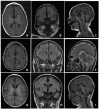Cognition and Evolution of Movement Disorders of FOXG1-Related Syndrome
- PMID: 31316448
- PMCID: PMC6611493
- DOI: 10.3389/fneur.2019.00641
Cognition and Evolution of Movement Disorders of FOXG1-Related Syndrome
Abstract
FOXG1-related syndrome is a rare neurodevelopmental encephalopathy characterized by early onset hyperkinetic movement disorders, absent language, autistic features, epilepsy, and severe cognitive impairment. However, detailed evaluation of cognition and evolution of movement disorders over time have not been clearly described before. In this study, we performed whole-exome sequencing in a cohort with unknown severe encephalopathy and movement disorders, with/without autistic behaviors. We identified FOXG1 mutations in three patients. One of them had a novel mutation that has not been described before. The neuropsychological test by Mullen Scales of Early Learning (MSEL) showed severe psychomotor impairments in all patients. There were uneven cognitive abilities in terms of verbal and non-verbal cognitive domains in all of them, with approximately 2 months differences. Gross motor skills and expressive language were more severely affected than the other domains in all the patients. All individuals had early onset hyperkinetic movement disorders. The movement disorders in one of our patients changed from predominantly hyperkinetic in early childhood to more hypokinetic in adolescence with the development of dystonia. To the best of our knowledge, this evolution had never been described before. In conclusion, individuals with FOXG1-related syndrome may show clinical progression from hyperkinetic to hypokinetic features over time. There were also uneven cognitive abilities in verbal and non-verbal cognitive domains. The FOXG1 mutation should be considered in individuals with a history of hyperkinetic movements, microcephaly, and uneven cognitive abilities with characteristic brain images.
Keywords: FOXG1; cognition; evolution; hyperkinetic; hypokinetic; movement disorder.
Figures


Similar articles
-
FOXG1-Related Syndrome: From Clinical to Molecular Genetics and Pathogenic Mechanisms.Int J Mol Sci. 2019 Aug 26;20(17):4176. doi: 10.3390/ijms20174176. Int J Mol Sci. 2019. PMID: 31454984 Free PMC article. Review.
-
The hyperkinetic movement disorder of FOXG1-related epileptic-dyskinetic encephalopathy.Dev Med Child Neurol. 2016 Jan;58(1):93-7. doi: 10.1111/dmcn.12894. Epub 2015 Sep 6. Dev Med Child Neurol. 2016. PMID: 26344814
-
Delineating FOXG1 syndrome: From congenital microcephaly to hyperkinetic encephalopathy.Neurol Genet. 2018 Nov 7;4(6):e281. doi: 10.1212/NXG.0000000000000281. eCollection 2018 Dec. Neurol Genet. 2018. PMID: 30533527 Free PMC article.
-
Early-onset movement disorder as diagnostic marker in genetic syndromes: Three cases of FOXG1-related syndrome.Eur J Paediatr Neurol. 2018 Mar;22(2):336-339. doi: 10.1016/j.ejpn.2018.01.007. Epub 2018 Jan 31. Eur J Paediatr Neurol. 2018. PMID: 29396177
-
Epilepsy in Rett syndrome, and CDKL5- and FOXG1-gene-related encephalopathies.Epilepsia. 2012 Dec;53(12):2067-78. doi: 10.1111/j.1528-1167.2012.03656.x. Epub 2012 Sep 21. Epilepsia. 2012. PMID: 22998673 Review.
Cited by
-
Conditional Deletion of Foxg1 Delayed Myelination during Early Postnatal Brain Development.Int J Mol Sci. 2023 Sep 10;24(18):13921. doi: 10.3390/ijms241813921. Int J Mol Sci. 2023. PMID: 37762220 Free PMC article.
-
Paving Therapeutic Avenues for FOXG1 Syndrome: Untangling Genotypes and Phenotypes from a Molecular Perspective.Int J Mol Sci. 2022 Jan 16;23(2):954. doi: 10.3390/ijms23020954. Int J Mol Sci. 2022. PMID: 35055139 Free PMC article. Review.
-
Hyperkinetic Movement Disorder Caused by the Recurrent c.892C>T NACC1 Variant.Mov Disord Clin Pract. 2024 Jun;11(6):708-715. doi: 10.1002/mdc3.14051. Epub 2024 May 2. Mov Disord Clin Pract. 2024. PMID: 38698576 Free PMC article.
-
Toward a mechanistic understanding of DNA binding by forkhead transcription factors and its perturbation by pathogenic mutations.Nucleic Acids Res. 2021 Oct 11;49(18):10235-10249. doi: 10.1093/nar/gkab807. Nucleic Acids Res. 2021. PMID: 34551426 Free PMC article. Review.
-
FOXG1-Related Syndrome: From Clinical to Molecular Genetics and Pathogenic Mechanisms.Int J Mol Sci. 2019 Aug 26;20(17):4176. doi: 10.3390/ijms20174176. Int J Mol Sci. 2019. PMID: 31454984 Free PMC article. Review.
References
-
- De Bruyn C, Vanderhasselt T, Tanyalcin I, Keymolen K, Van Rompaey KL, De Meirleir L, et al. . Thin genu of the corpus callosum points to mutation in FOXG1 in a child with acquired microcephaly, trigonocephaly, and intellectual developmental disorder: a case report and review of literature. Eur J Paediatr Neurol. (2014) 18:420–6. 10.1016/j.ejpn.2013.11.010 - DOI - PubMed
LinkOut - more resources
Full Text Sources

